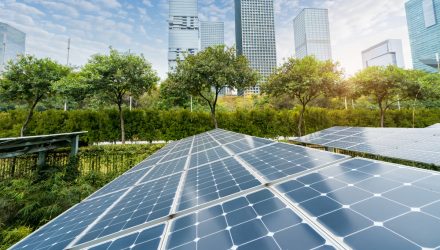By CIBC, the index provider on the ALPS Clean Energy ETF (ACES)
Once relegated to the sidelines of investors’ attention due to broad overreliance on subsidies and a lack of economic edge vs. traditional energy, clean energy and clean technology are in the midst of a new era of growth and competitiveness. Although wind and solar capacity have been expanding rapidly for over a decade, utilities have only recently wholeheartedly embraced both renewable sources as key generation technologies to upgrade power plant fleets, which has dramatically accelerated the large-scale shutdown of coal.
Meanwhile, the stability of hydropower and geothermal power has been steadily generating baseload energy for decades. When combining all renewable sources, 2019 marked the first year in the modern electric era that renewable energy surpassed coal in the U.S. energy supply mix. In fact, countrywide annual energy consumption from coal has reached its lowest level since 1964 in the U.S. [1]
“2019 coal use was the lowest since 1964, and clean energy surpassed coal in the U.S.”
In addition to the continued trend of renewable energy additions, clean technology will play a key role in achieving greater energy efficiency to help us both conserve energy and minimize greenhouse gas emissions, while also supporting continued economic growth. Advances in technologies are enabling a smart grid capable of integrating more distributed sources of energy while at the same time being more resilient. Other technologies are allowing us more control over the energy we use in order to consume less or use it in entirely new ways.
Nowhere is this technology disruption more evident than in the electrification of transportation. As the technology has advanced, all types of vehicles are being electrified—from passenger cars to large commercial trucks—improving the outlook for electric vehicles and fuel cell technologies. Given the meaningful reduction in emissions from the electric sector over the past decade, transportation is now the largest source of greenhouse gas emissions in the U.S., accounting for approximately 28% of the total.[2]
Biofuels and biomass form another option for alternative fuels and renewable electricity generation. Next-generation biofuels and modern biomass are helping to secure our energy supply and reduce greenhouse gas emissions.
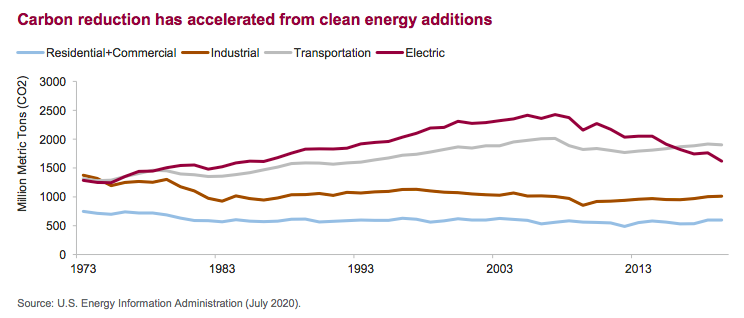
Numerous policy support initiatives are being proposed around the world, further reinforced by stimulus spending broadly, as momentum builds to address climate change. However, what is clear is that governments are accelerating efforts to transition to a clean energy future through further incentives, more stringent mandates and potentially a more prevalent price on carbon. In addition, as technology continues to drive down costs, more companies are speeding up their own transition plans with meaningful commitments to lowering net carbon emissions.
Dozens of U.S. utilities and other large corporations have committed to net-zero emissions in the coming decades.[3] All of this culminates in an attractive investment environment for the companies delivering on the promise of clean energy today.
“The renewables origination success remained particularly strong, with the team adding more than 5,800 megawatts to our backlog over the past year as we continue operating in what we believe to be the best renewables development environment in our history.” – Jim Robo, CEO, Nextera Energy, January 24, 2020
Electric vehicles/storage
Electric vehicles (EVs) are increasingly accepted as viable alternatives to internal combustion engines as battery technologies improve, charging infrastructure is built out, and car companies offer an expanded range of models. Bloomberg New Energy Finance (BNEF) estimates that electric SUVs and large cars will reach price parity with traditional internal combustion engines by 2022 due to lower fuel efficiency of traditional internal combustion engines, followed by small and medium-sized vehicles in 2024.[4] In fact, electric vehicles encompass much more than just passenger vehicles, with substantial potential for other uses, including buses, scooters, and commercial vehicles, like delivery vans, garbage trucks and long-haul tractor trailers.
California and other states are already putting mandates in place, such as the Advanced Clean Trucks (ACT) rule, that broadly seek to achieve sales of only zero-emission commercial vehicles by 2045.[5] These types of policies are often accompanied by hundreds of millions of dollars in spending for EV charging infrastructure, which should help minimize consumer anxiety around range and further the adoption of electric vehicles.
“Based on the chart, by 2035, analysts project over 100 million electric vehicles will be sold worldwide, including over 40 million electric passenger vehicles.”

In addition to powering the shift to EVs, batteries are also enabling further penetration of renewables. Due to the intermittent nature of wind and solar, continued adoption of renewables will require storage to provide backup power and maintain grid stability. Stationary storage becomes the critical link to provide that resiliency. Battery storage has emerged as a solution, given its rapidly declining cost and improved safety and performance. Pairing batteries with renewables extends the time that renewable power can meet demand as well as smooths out the inherent fluctuations that come from the wind and sun.
Utilities have already begun to install large-scale batteries on the grid with projections for a massive increase in deployments to come. At the end of 2018, the U.S. had 1.5 gigawatts (GW) of energy storage systems installed, which is expected to increase over 100 times to 178 GW by 2040, according to BNEF.[6]
Fuel cell
Fuel cells use an electrochemical process to convert fuel and oxygen from the air into electricity, water and heat. Depending on the fuel source, fuel cells could play a key role in decarbonizing the world economy over the coming decades. There are a number of technologies being pursued, but most rely on some combination of materials to split molecules into protons and electrons to generate electricity. Already, the global market in 2019 reached approximately 70,000 units shipped, equivalent to 1.2 GW of power.[7]
Fuel cells often use hydrogen as an input to produce electricity but can also use alternatives like renewable natural gas as it becomes more widely available. In particular, pairing fuel cells with hydrogen produced with renewable energy, known as green hydrogen, holds real promise to significantly reduce carbon emissions from some of the more energy-intense segments of the economy. The most obvious application is to decarbonize the heavy transportation industry, particularly heavy-duty trucking and shipping, which requires travel over long distances between refueling. There are several other applications not well suited to battery electric solutions that are expected to help drive broad-based hydrogen and fuel cell adoption as well, including industrial energy, building heat and stationary power generation.
According to industry analysts, the global fuel cell market is poised to grow from 1 GW in 2019 to 133 GW by 2030 and 2,500 GW by 2050. While significant cost declines are necessary to drive widespread adoption, this level of deployments could still equate to sales increasing from $300 million in 2019 to $12.5 billion by 2030 and $150 billion by 2050.[7]
One of the main challenges to scaling hydrogen use in fuel cells while keeping emissions low is transitioning from fossil fuel based production (grey hydrogen) to fossil fuel-based production with carbon capture and storage (blue hydrogen), and finally to full renewable-energy electrolysis (green hydrogen). But the rapid expansion of wind and solar, driven by significant cost declines, will help achieve this as well. In fact, the cost of electrolysis fell 60% from 2010 to 2020 and is expected to fall another 60% by 2030.[8]
“Fuel cell sales could increase from $300 million in 2019 to $150 billion by 2050.”
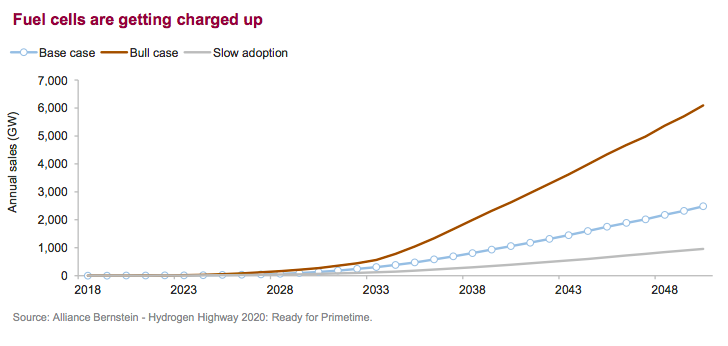
Wind Wind energy has been one of the fastest-growing technologies in the electric generation mix of the U.S., growing from only 6 billion kilowatt hours in 2000 to 300 billion kilowatt hours in 2019, making up over 7% of U.S. utility scale electricity generation and surpassing hydro as the most-used renewable source in the country. [9],[10] Total wind capacity was over 105 GW in the U.S. at the end of 2019, and the wind industry supported over 120,000 jobs in the country (25,000 in Texas alone).[11]
Although the wind industry has been supported by tax credits historically, government support is much less relevant today. Utilities are increasingly supportive of wind energy, as evidenced by the substantial increase in market share of electricity generation in the U.S. The largest wind developer in the country, NextEra Energy, projects that wind and solar will be costcompetitive with existing coal and nuclear power generation in less than five years with no subsidies.[12]
The economics of wind power are largely based on turbine size and height, and wind turbines have consistently grown in size and scale for decades. The secret of wind economics lies in the fact that larger blades generate exponentially more power as they capture significantly more wind. In the mid-1990s, average wind turbines had less than 1 megawatt capacity, were approximately 50 meters in diameter, and were approximately 80 meters tall from bottom to tip.[13] Modern wind turbines are substantially larger, and the largest turbine in the world has already reached 12 megawatt capacity, 220 meters in diameter, and 260 meters in height. Furthermore, it is capable of generating power for 16,000 households with a single turbine.[14] Large wind installations can reach into the hundreds of turbines. While the average turbine installed today is not this large, future turbine trajectories continue to increase in size, power and generation, while cost is lower.
“Wind power generates over 7% of U.S. electricity already and is the number one source of renewable energy in the U.S.”
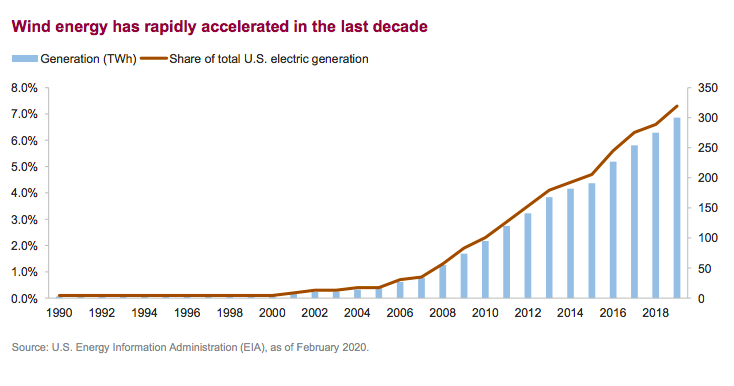
Solar
Solar energy has expanded rapidly in the U.S. and globally over the last decade, accounting for over 35 GW of existing utility and small-scale power production capacity by year-end 2019 in the U.S., compared to only 0.4 GW in 2010.[15] However, this compares to approximately 1,100 GW for the total U.S. power-generating capacity, so solar is still a relatively small portion of the total and is a similarly low percentage of the total in most advanced economies.
While the majority (95%+) of the electricity is produced by photovoltaic (PV) power cells, solar thermal generation can help provide power when the sun is not shining, though advances in battery technology are making a combination of PV power cells and batteries increasingly viable. Additionally, small-scale rooftop solar is increasingly important, since many houses can support solar panels. It is this sizing and scalability that makes solar unique among renewable technologies, as it can apply to anything from a calculator battery to a massive utility-scale solar installation. Like much of the renewable energy industry, solar’s success is due in large part to massive cost reductions: U.S. average PV system costs have dropped more than 70% over the last decade.[16]
While solar PV has been used for decades, electric utilities only started to embrace solar as a cost-competitive source of generation between 2015 and 2020, which substantially accelerated industry growth. According to the Edison Electric Institute, more than half of all new electricity generation capacity added over the past eight years in the U.S. has been wind and solar. 15 As of 2019, carbon dioxide emissions from the electric power sector are approximately 30% lower than 2005 levels, and the industry is targeting an 80% reduction by 2050, with some companies going beyond this and targeting a net-zero carbon emissions in that same time period.[17] The electric industry’s most obvious method to achieve this is through replacing fossil fuel-based generation, particularly coal, with renewable generation sources like wind and solar, which also need to be paired with battery storage for supply when renewable resources are low. While the U.S. provides an illustrative example of the power of renewables, global deployments annually are well above 100 GW and are projected to nearly double over the next decade, with further growth beyond, as shown in the chart.
“Average cost of solar has declined 70% since 2010, and global annual installations could double in the next decade.”
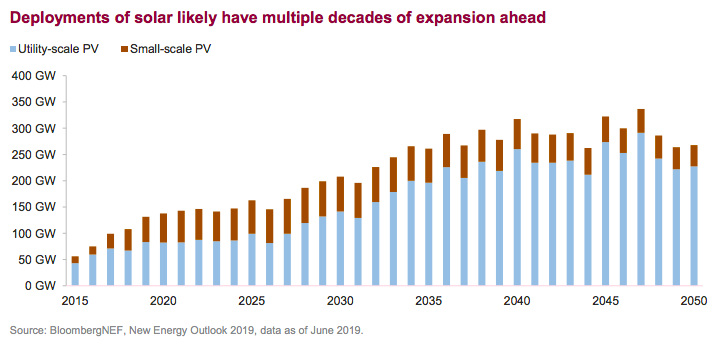
Efficiency/LED/smart grid
The number one most effective way to reduce carbon emissions and other pollutants is through not using the energy to begin with, which is the goal of energy efficiency broadly. The International Energy Agency (IEA) measures energy intensity of economies around the world, and data over the last several decades has shown a clear decoupling of economic growth from energy usage. Said differently, gross domestic product is increasing faster than energy consumption over time. For example, the energy intensity of economies decreased globally by 35% between 1990 and 2017, with greater declines in countries outside of the Organization for Economic Co-operation and Development.[18] While much of this decline is from structural shifts towards technology in advanced economies, clean technology also had a role to play in the form of products specifically designed to reduce energy use, like light-emitting diodes (LEDs), advanced materials and smart grids.
While LEDs were considered too expensive for consumer or commercial use just a few years ago, they have largely replaced incandescent bulbs in the U.S. and can easily last 10 times as long as older technologies while using a fraction of the power. LEDs have largely shifted to a more mature technology, but other energy efficiency products are still being developed and deployed on a regular basis, conserving electricity and saving businesses money. For example, advanced composite materials help reduce the weight of electric vehicles to extend their driving ranges, while superconductors increase efficiency of electrical transmission to reduce line loss.
The electrical grid has been deployed in some form since the early 1900s, but the modern electrical grid is increasingly dependent on advanced technology, multi-way communication and grid resiliency—all of which fall under the umbrella of a smart grid. The traditional U.S. electrical grid is a true engineering marvel, made up of hundreds of thousands of miles of transmission lines, thousands of power plants, over five million miles of distribution lines, and innumerable substations, transformers and meters.19 However, the grid of the 21st century is increasingly focused on making the grid smart. For example, smart meters enable two-way communication, electricity synchronization, complex minute-by-minute shifts to account for smart electronics and can also help integrate distributed and intermittent energy generation (like rooftop solar). U.S. consumers and businesses are more reliant on the electrical grid than ever before, so much of the smart grid will increasingly blur the lines between network security, efficiency, grid resiliency to reduce outages, and better integration with smart electronics. Ultimately, the smart grid will enable the electrification transformation by helping bring all of these various technologies together more effectively.
“In the span of 10 years, the U.S. increased advanced metering penetration from 5% to over 50%.”
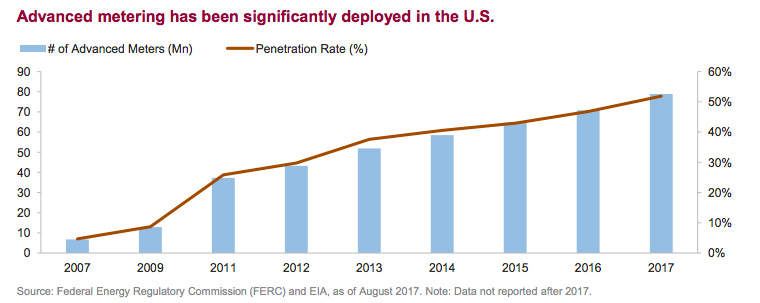
Biomass/biofuel Biomass and biofuels are renewable fuels derived from plants or waste feedstocks, used either to produce electricity like a traditional power plant or to replace petroleum products for use as liquid fuels. First-generation biofuels, principally ethanol and biodiesel, account for the majority of liquid biofuels produced in the U.S. today at approximately one million barrels per day.19 In the U.S., biofuels have received substantial government support and have been criticized for competing with food consumption, rendering them less popular recently from an economic and food security standpoint. However, next-generation biofuels, like renewable diesel, cellulosic ethanol and algae-derived fuels, hold more promise in the future. Modern biomass energy production based on sustainable forestry practices is growing rapidly to displace coal and significantly reduce net carbon emissions. In addition, capturing methane (natural gas) from renewable sources such as landfills, water treatment plants, agricultural and forest residue is particularly effective at reducing greenhouse gas emissions as it prevents natural release. As a result, the development of renewable natural gas (RNG) offers another clean pathway to economically source energy from biomass today and doesn’t require any changes to the country’s gas distribution systems. A recent study by the American Gas Foundation (AGF) estimates there are between 1.5 to 3.7 trillion British thermal units of recoverable renewable gas resource in the U.S., enough to displace approximately 5% to 13% of current U.S. natural gas consumption.20
“Renewable natural gas has potential to displace 5% to 13% of U.S. gas consumption.”

Hydro/geothermal
Hydroelectric and geothermal plants use natural resources to produce electricity from sources that are able to provide baseload power, either year-round (geothermal) or seasonally (hydro). Unlike wind and solar, both hydro and geothermal are more limited in their ability to grow given their dependence on available resources, but they are expected to remain an important component of the renewable energy mix, given their more consistent generation profile. The world’s first hydroelectric power plant was commissioned in 1882, and there are still several hydroelectric dams operating today that were built before 1930.18 This makes hydroelectric-generating stations the oldest power plants in the U.S. The vast potential of running water also allows for massive installations that can dwarf fossil fuel plants with the right resources. The Robert-Bourassa hydroelectric-generating station in northern Quebec, Canada has a capacity of 7.7 GW—almost twice as large as the largest U.S. nuclear plant capacity (Palo Verde: 3.93 GW). But even this is much smaller than the Three Gorges Dam in China, which has a generating capacity of 22.5 GW and is the largest power plant in the world. Hydropower is one of the steadiest and simplest solutions to generating renewable energy at a relatively low cost, given scale benefits. Similar to hydropower, geothermal power plants have been operating for many decades, although the technology is less mature and is only cost competitive with conventional power in regions where magma heat is close to the surface of the earth. The largest geothermal complex in the world is located at The Geysers in California and is a series of power plants which are roughly comparable to a medium-sized fossil fuel plant.21 Utility-scale geothermal usually operates on steam production and is also capable of providing baseload power since the earth’s molten core is a constant source of energy.
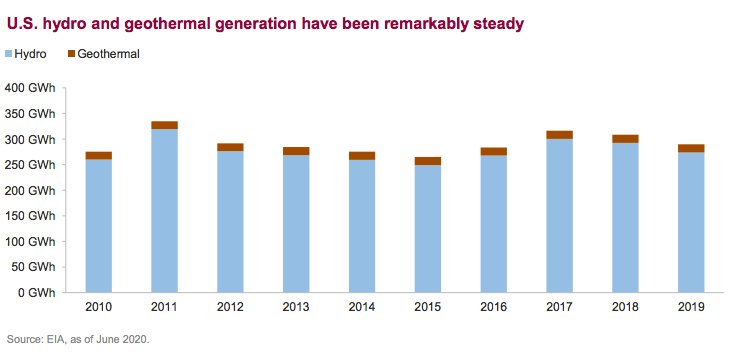
1. https://www.eia.gov/todayinenergy/detail.php?id=43895
2. https://www.epa.gov/ghgemissions/sources-greenhouse-gas-emissions

